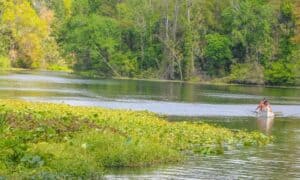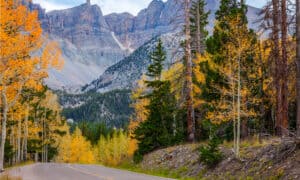The Rocky Mountain National Park spans more than 256,000 acres across Colorado. There are countless trails to hike and places to see. But what are some of the best activities when visiting Rocky Mountain National Park? Below are 15 Reasons Rocky Mountain National Park needs to be on your bucket list. You won’t be disappointed.
1. Surround Yourself With Breathtaking Views
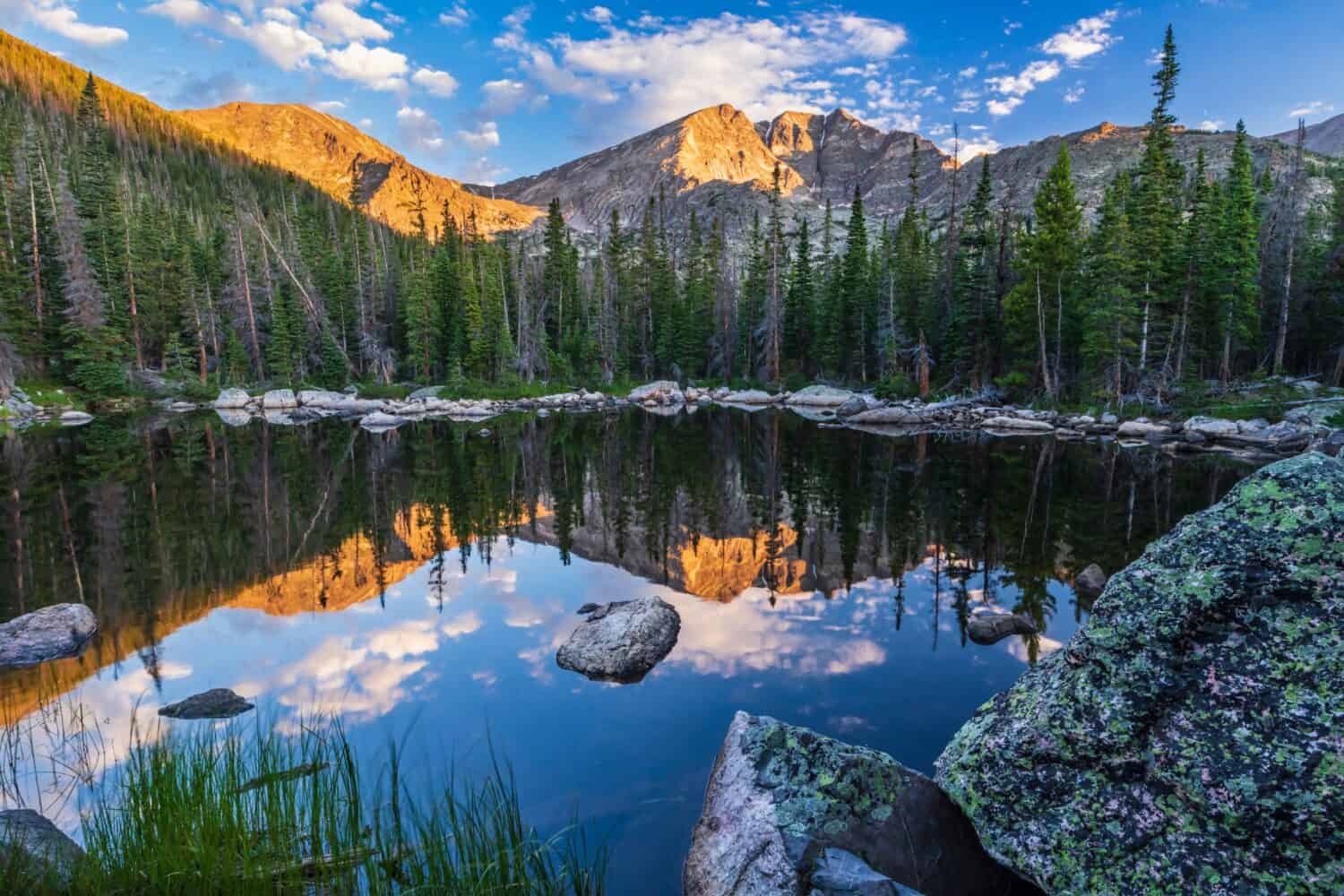
Ypsilon Mountain is a soaring 13,514 feet.
©Colin D. Young/Shutterstock.com
Determining the best views at Rocky Mountain National Park is almost impossible. But finding the most breathtaking natural sights is one of the biggest reasons Rocky Mountain National Park needs to be on your bucket list. The park is stunning everywhere you go; we cover many of them throughout this article. There are mountains, lakes, meadows, waterfalls, and almost everything you can imagine throughout the 256,000 acres.
However, Bear Lake is a classic and popular spot. The water looks like glass on a calm day, creating an almost perfect mirror image of the peaks above. An honorable mention is Mummy Range. It’s located in the northern portion of the park and resembles the profile of a mummy. Six of the mountains are higher than 13,000 feet, including Ypsilon Mountain, which is a soaring 13,514 feet. The Arapaho call them White Owls because the snow lingers on their peaks longer than the others.
2. Hike Along Some of the Best Trails in the U.S.
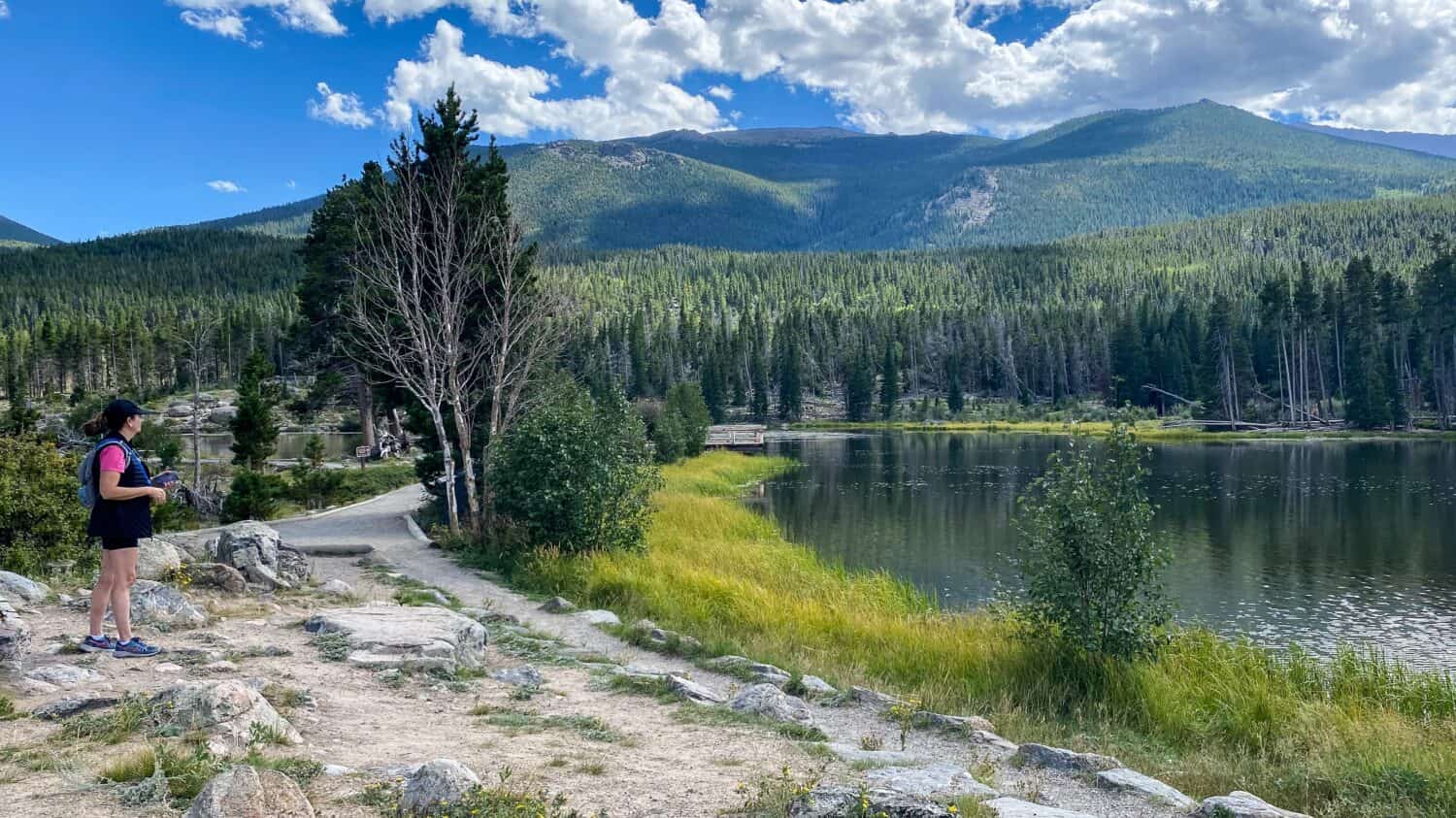
The Sprague Lake Hike is one of the most popular hiking trails in the Rocky Mountain National Park.
©Kurt Nichols/Shutterstock.com
The spectacular hiking trails are among the biggest reasons Rocky Mountain National Park needs to be on your bucket list. The Rocky Mountain National Park has more than 80 hiking trails that span 355 miles. You don’t have time for all of them in one trip, but you can explore a few. You can keep a list of the remaining trails you’d like to explore and use it as motivation to come back.
Some of the best trails to start with include:
- Bear Lake Trail
- Lake Haiyaha Trail
- Alberta Falls Trail
- Nymph, Dream, and Emerald Lakes Trail
- Alpine Ridge Trail
- Sprague Lake Trail
- Gem Lake Trail
- Deer Mountain Trail
- Glacier Gorge Trail
- Twin Sister Peak Trail
3. Get Up Close and Personal With Native Wildlife

Try to find a camouflaged white-tailed ptarmigan in the tundra of the Rocky Mountain National Park.
©Carrie Olson/Shutterstock.com
The Rocky Mountain National Park needs to be on your bucket list if you’re an animal lover. The park is one of the nation’s top wildlife viewing destinations because it’s home to over 300 species.
A park favorite includes the elk, which can be seen at any time of the year. You can find them in the meadows or at the forest’s edge. The best time to spot them is at feeding time, at dawn or dusk. Mule deer are also one of the most commonly spotted animals. Find them anywhere in open areas at high elevations.
Some of the most common birds along Trail Ridge Road are golden eagles, prairie falcons, Steller’s jays, and Clark’s nutcrackers. However, one of the most sought-after birds is the white-tailed ptarmigan. They are difficult to spot because they stay very still to blend into the tundra. If it’s your dream to see one of these beautiful yet elusive birds, then here’s another reason the Rocky Mountain National Park needs to be on your bucket list.
As of 2012, 141 species of butterflies alone were recorded at the park. The most commonly spotted species are the Mormon fritillary, painted lady, small wood-nymph, spring azure, and arctic blue. Other insects include the tent caterpillar, the pinacate beetle, and the crab spider.
4. Take a Once in a Lifetime Photo
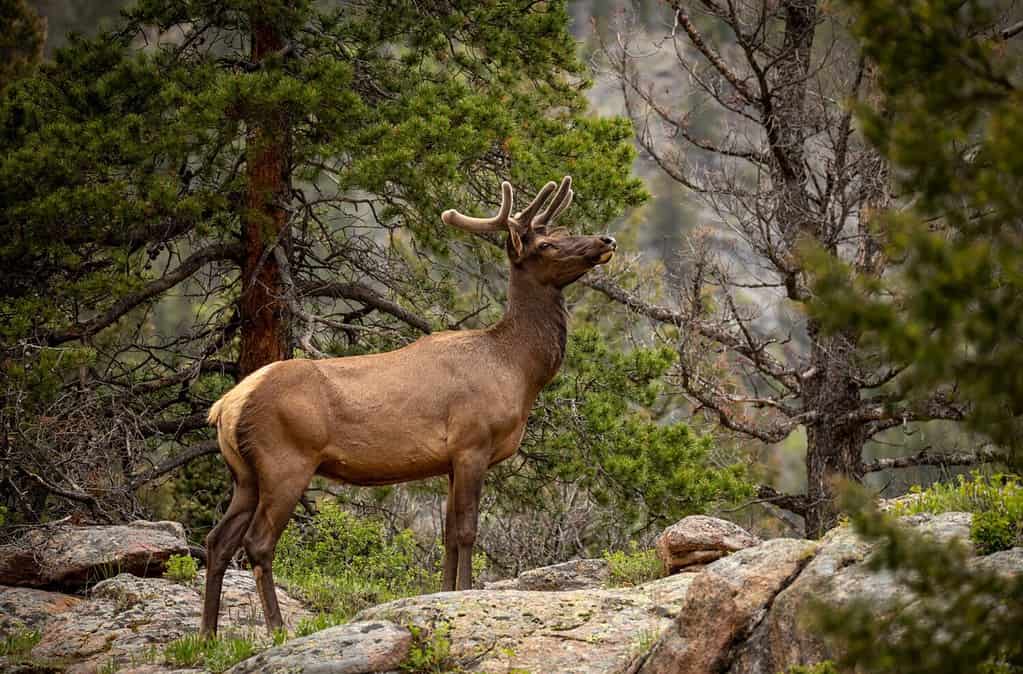
Roosevelt elk roam through the vast landscape of the Rocky Mountain National Park.
©DanaForeman/Shutterstock.com
If you don’t have photos to prove it, did you really go to Rocky Mountain National Park? No matter what you see, you’ll come home with breathtaking pictures to show your friends and family. But you might be in for a treat and have a safe animal encounter while exploring the park. If that’s not enticing enough to be one of the main reasons Rocky Mountain National Park needs to be on your bucket list, I’m not sure what is.
Use your phone or a camera to get the perfect shot of an elk, a bighorn sheep, a colorful butterfly, or one of the elusive white-tailed ptarmigans, if you’re lucky. Stay about 75 feet away from elk and bighorns, and about 120 feet away from moose and bears. Having an up-close encounter with a wild animal and getting a picture to prove it is a dream come true. But be respectful and don’t touch or feed the animals for your safety and there’s.
5. Go for a Scenic Drive
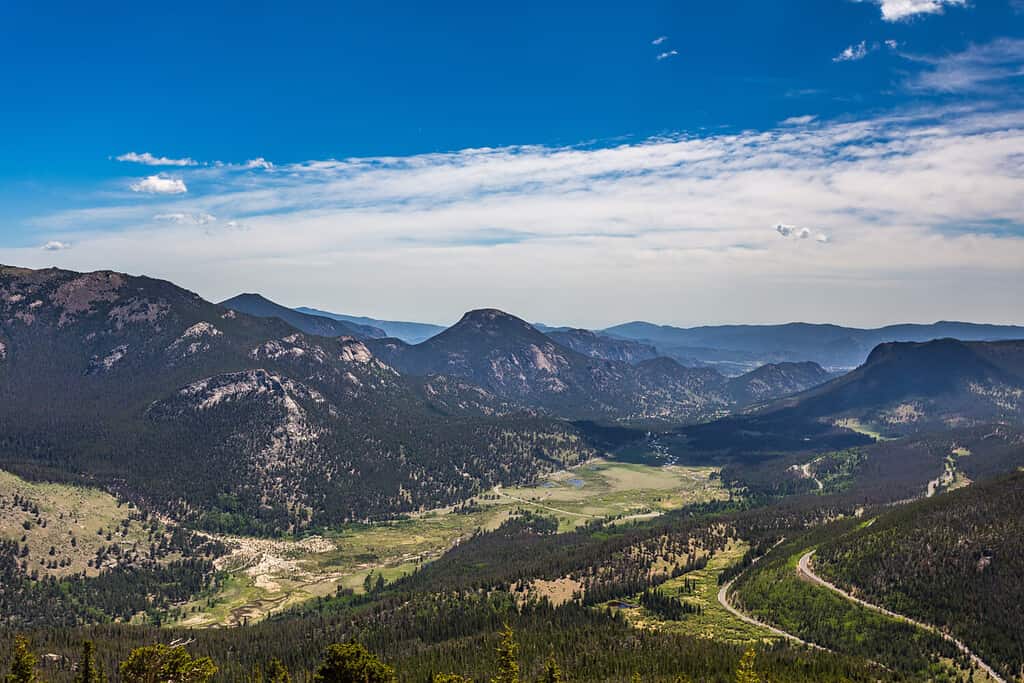
Trail Ridge Road offers stunning views from Estes Park to Grand Lake, Colorado.
©Beach Creatives/Shutterstock.com
Old Fall River Road
Old Fall River Road is a narrow, dirt road that takes you through 9 miles of the park from the Endovalley Picnic Area to the Fall River Pass. From here, you can see Mount Chapin and Chasm Falls. Drive through the sub-alpine and into the alpine on this seasonal road like no other. But watch out, the winding road can be dangerous.
Trail Ridge Road
Trail Ridge Road is one of 10 America’s byways in Colorado and is a national designated All American Road. This famous roadway covers 48 miles between Estes Park and Grand Lake. It’s also 11 miles above the treeline, and 11,500 feet overall. You will journey from the aspen and ponderosa pine forests to the subalpine forests with fir and spruce. You’ll feel like you teleported from Colorado to the Canadian or Alaskan wilderness. It’s cold, and the colors are vivid. Among the tundra, you might spot pikas, marmots, bighorn sheep, or any of the 200 species of alpine plants along the ground.
6. Camp Under the Stars
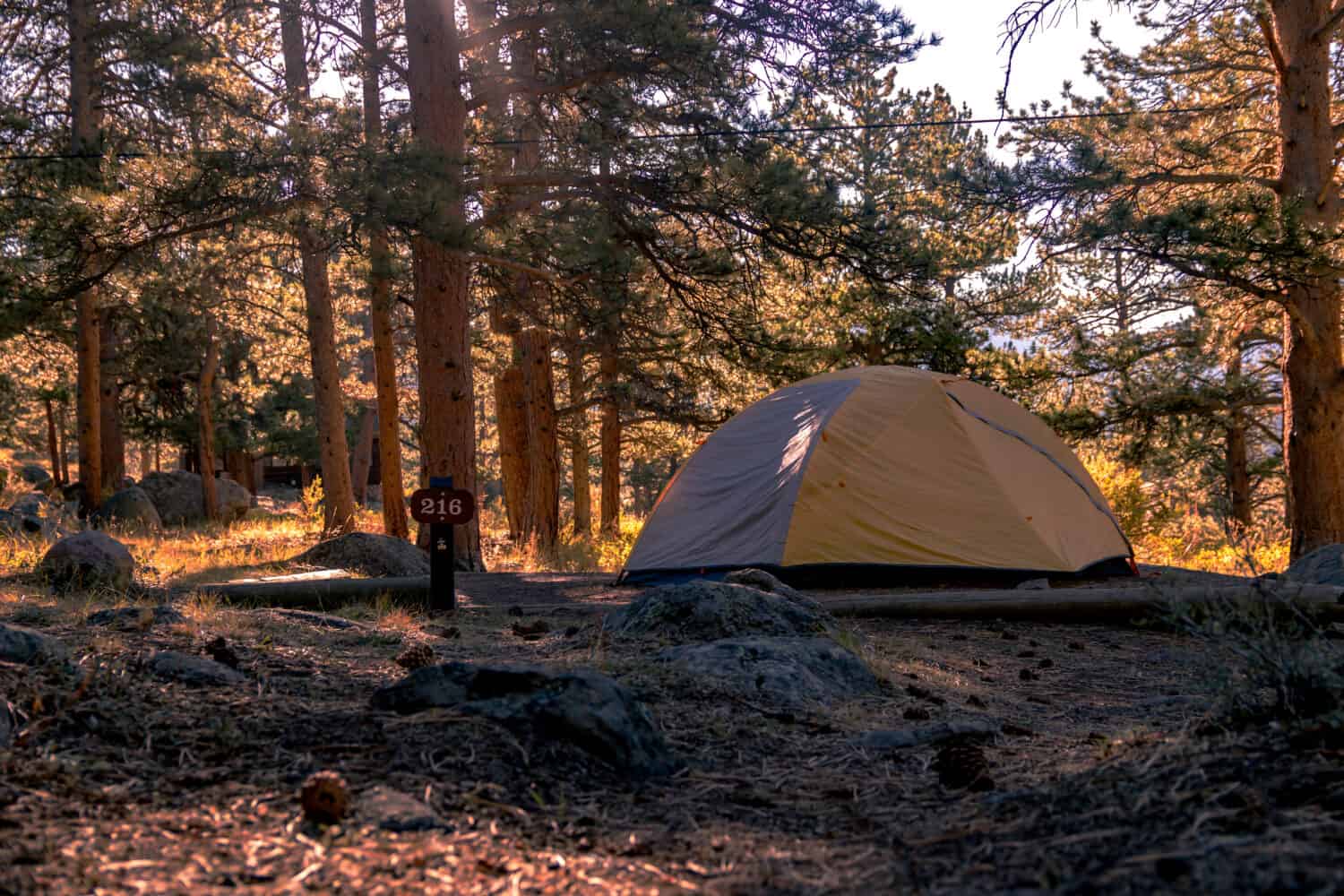
Unplug and get close to nature by camping at Rocky Mountain National Park.
©Mr.Denzilla/Shutterstock.com
There are a number of places to camp in the Rocky Mountain National Park. But how do you choose where to go? Timber Creek is only 10 miles inside the park from the Grand Lake entrance, with 98 available spots. The elevation is 8,900 feet, but offers amenities, including flush toilets.
If you want to get closer to nature, the Longs Peak Campground and climber base camp outside of Estes Park are tents only. However, the area is first come, first served and is at an elevation of 9,500 feet. It gets cold, so bring layers.
However, if you’re camping with an RV and want to disconnect from the world, Aspenglen Campground is open from May to September. The campground is near the Fall River entrance in the pine forest, the 8,200-foot elevation makes for perfect stargazing.
7. Watch an Unforgettable Sunrise

Bear Lake is one of the most popular spots to watch the sunrise.
©Phanom Nuangchomphoo/Shutterstock.com
One of the top Reasons Rocky Mountain National Park needs to be on your bucket list is to see the sunrise. There are immeasurable places to watch the sunrise in Rocky Mountain National Park. But some views are better than others. The hike to Lake Haiyaha will reward you with a sunrise over boulders and rocky outcroppings. However, the short walk from the parking lot to the peacefulness of Lake Sprague is unmatched. This spot is busier but comes with a chance of spotting a majestic elk.
Bear Lake is also among the most popular sunrise spots, especially in fall. The lake reflects the sky’s colors, turning the scene into art. You won’t see a sunrise quite like it anywhere else. Furthermore, it’s at the beginning of the Emerald Lake and Lake Haiyaha trail.
8. Hear the Roar of a Waterfall
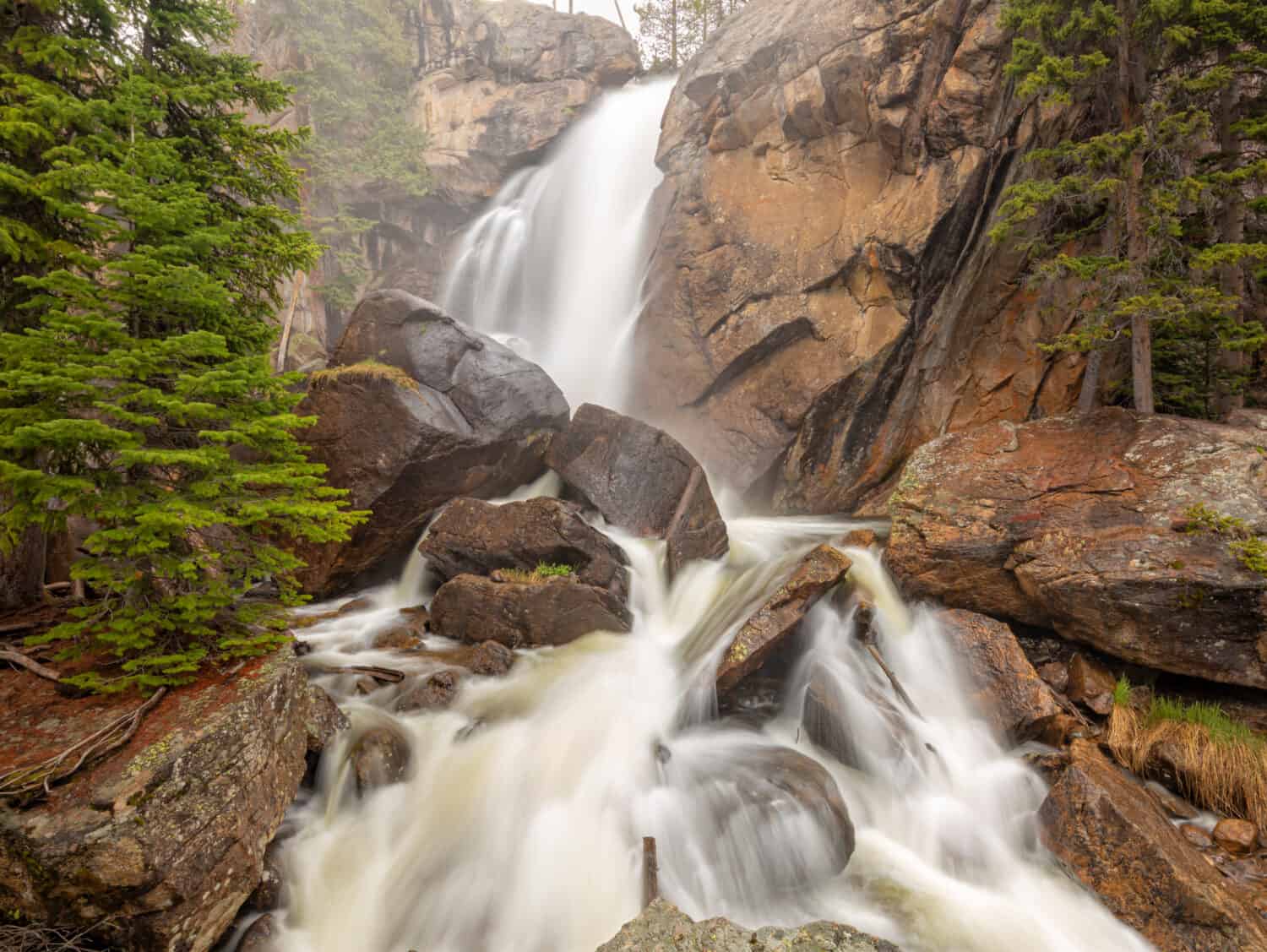
Ouzel Falls is named for the American dippers who “dip” their heads into the water.
©Colin D. Young/Shutterstock.com
There are 31 named waterfalls in the Rocky Mountain National Park. But one of the most impressive views belongs to Ouzel Falls. The trail to the 40-foot waterfall begins at the remote Wild Basin Trailhead. On the way, you will see Copeland Falls and Calypso Cascades. Due to spring runoff, the 300-foot cascade roars to life during the season. This mildly challenging route is popular for hiking and backpacking and leads you to Ouzel Falls. The waterfall is named after water ouzel, or American dippers, who “dip” their heads into the fast-moving water. For a more accessible waterfall, you can visit Chasm Falls. The trail to the 25-foot waterfall is near Estes Park. You can watch the water spill over the granite chasm from a viewing platform.
9. Get Your Toes Wet at the Alluvial Fan
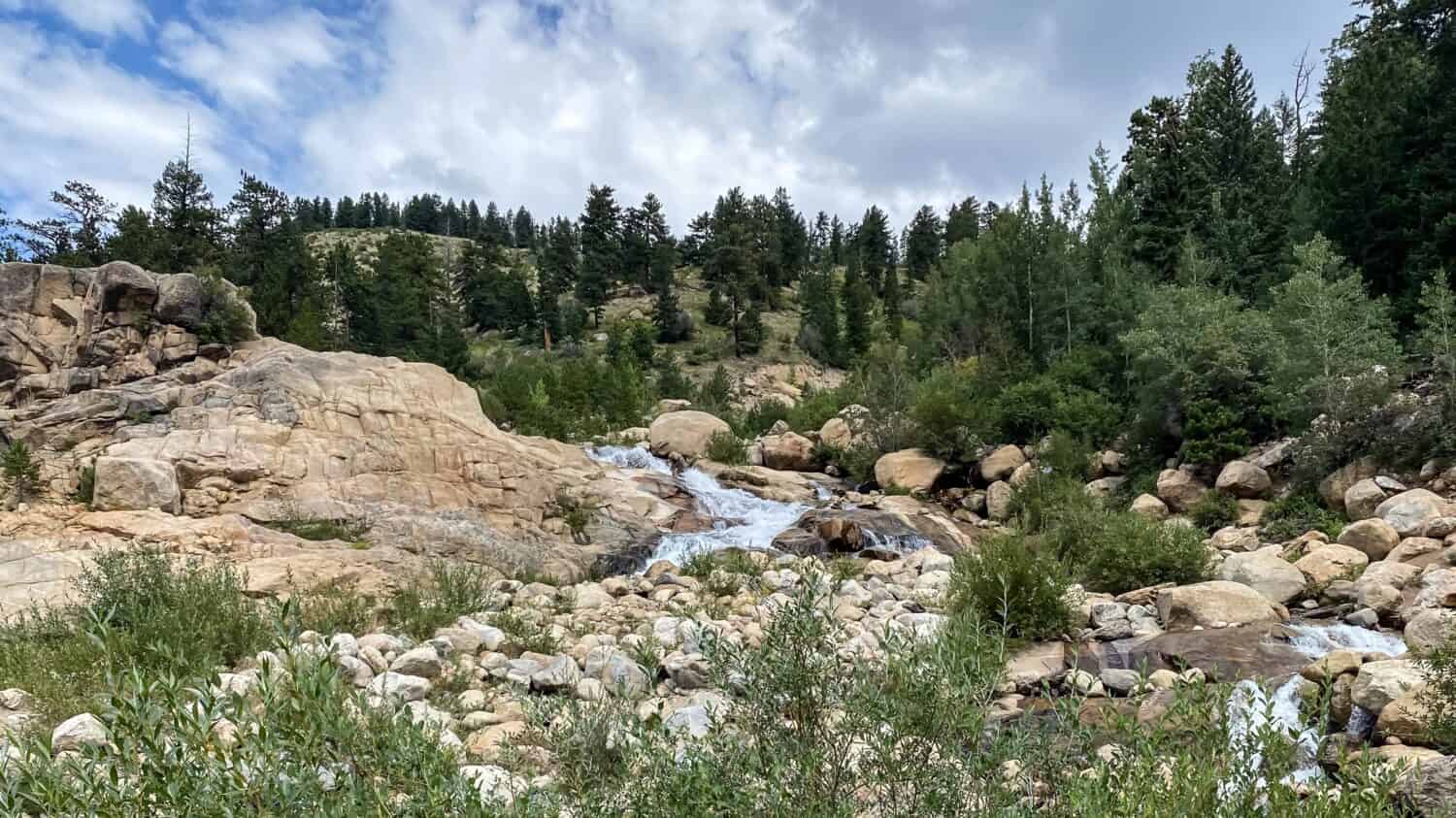
The Alluvial Fan was created by accident.
©Kurt Nichols/Shutterstock.com
Off the road to Endovalley is the Alluvial Fan. The Alluvial Fan was created in 1982 when a man-made dam 6 miles from the Roaring River failed, sending boulders down the valley and creating the Alluvial Fan. A trail was built across it in 1985, and it’s been a popular tourist destination ever since. The stunning cascade of water features a 56-foot bridge and is wheelchair accessible. Hikers can look at Endovalley, the Mummy Range, and Horseshoe Falls from here.
10. Picnic With Elks
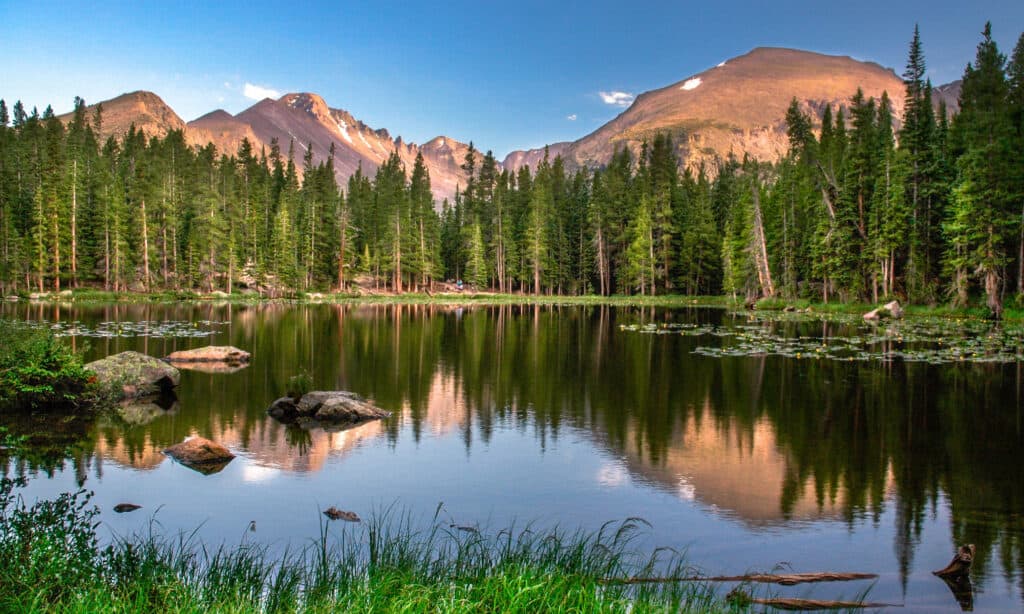
Dream Lake is a peaceful picnic spot to stop and rest in the Rocky Mountain National Park.
©iStock.com/Gerald Zaffuts
Share a meal outdoors with your loved ones in one of the many designated picnic spots throughout the Rocky Mountain National Park. On the east side, there are 16 picnic areas, including Hidden Valley, Lily Lake, and Beaver Meadow. Then the west side has 10 picnic areas including the Colorado River, Coyote Valley, and Harbison Meadows. Some destinations are more popular than others, and they require reservations. However, you have the chance to see a herd of elks run through the beautiful Rocky Mountain landscape as you relax.
11. Rock Climb in Lumpy Ridge

Lumpy Ridge is also one of the most popular rock-climbing areas in the park.
©Glenn Taylor/Shutterstock.com
Lumpy Ridge Loop, also called Twin Owls Loop, is north of Estes Park—the trail circles around Lumpy Ridge, a massive granite rock outcropping sculpted by the weather over billions of years. You can hike through the area by following the path to see Longs Peak and the mountains along the Continental Divide, as well as Gem Lake.
However, Lumpy Ridge is also one of the most favored rock climbing areas. The climbs are moderately long, with an average of two to five pitches. One of the most popular formations is The Book, while Sundance Buttress is the tallest cliff. Look out for closures due to raptors. Peregrine and prairie falcons, red-tailed hawks, and Cooper’s hawks are some of the raptors that nest near the Lumpy Ridge climbing areas.
12. Attend a Ranger Program
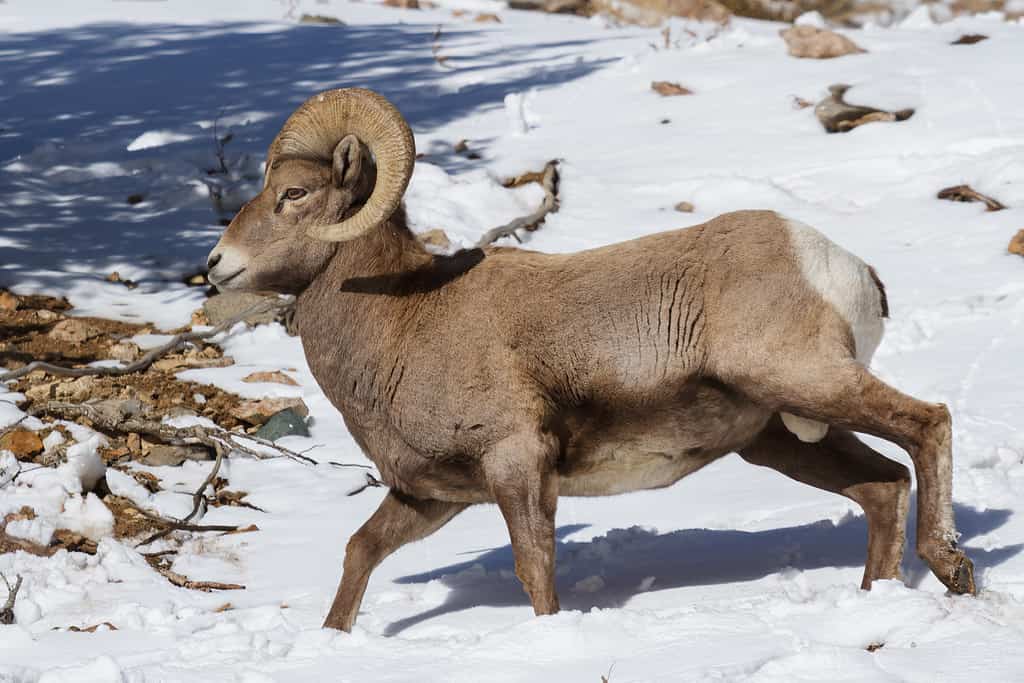
Learn about the wild bighorn sheep living in the Rocky Mountains of Colorado.
©iStock.com/Gary Gray
There’s no better way to learn about a new place than by hearing from the experts. The Rocky Mountain National Park offers free ranger-led programs to teach you about this incredible place. They provide insight based on knowledge and personal experience working alongside the native plants and wildlife, geology, and human history of the park. Ranger programs can enhance your once-in-a-lifetime experience with their expertise.
There are a variety of other educational programs to participate in. Some include interactive talks about bears, bighorn sheep, elk, and other park residents. You can even visit the park greenhouse and learn about restoration efforts. Rangers also lead hikes, pointing out things you might have missed if you were by yourself. They also hold presentations using a combination of education and visual storytelling to keep lectures interesting.
13. Tour the Holzwarth Historic Site
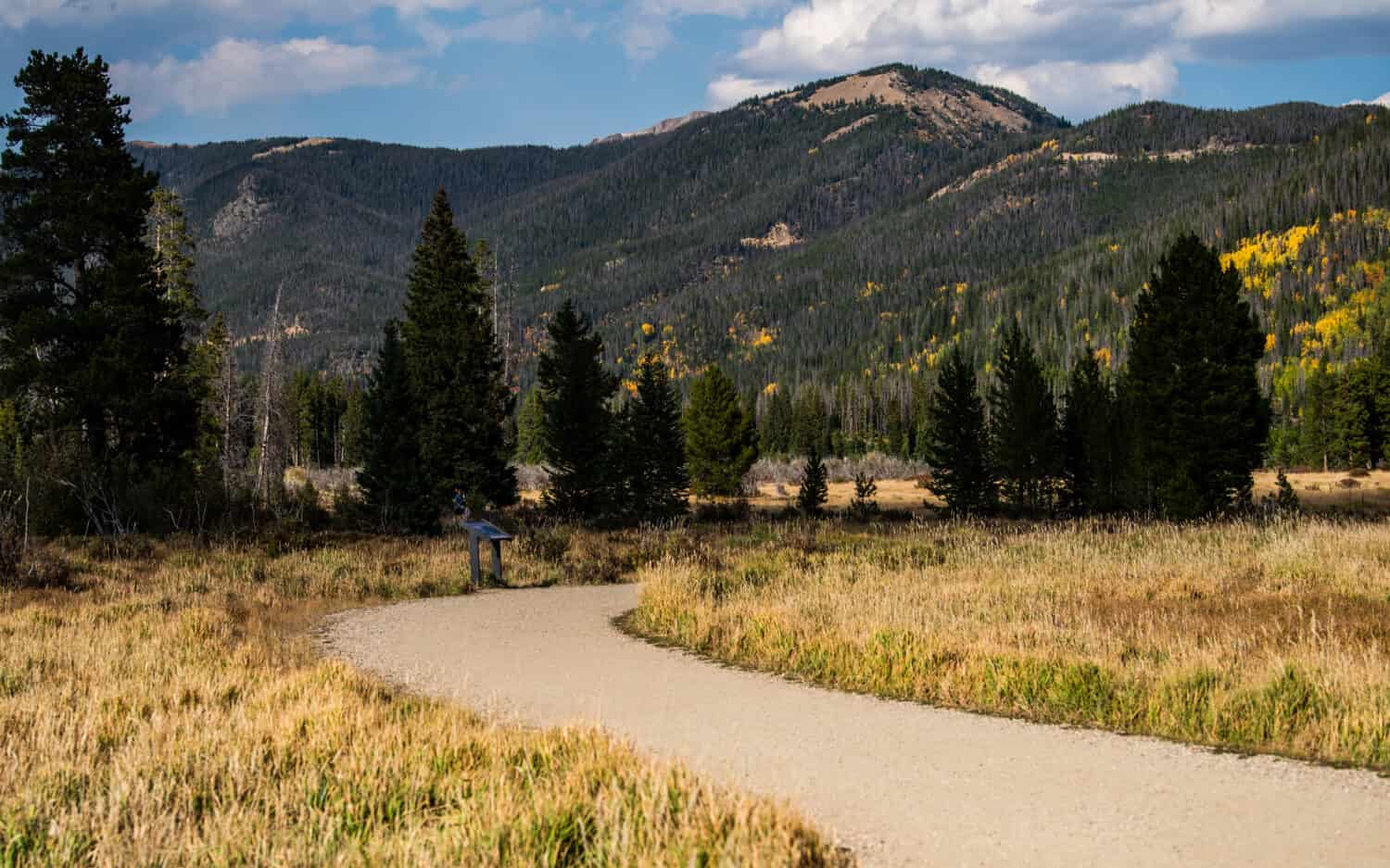
Hike to one of the original dude ranches in Colorado.
©Jeff Olivier/Shutterstock.com
Learn what it was like in the 1920s to stay in a luxury Colorado dude ranch. Or step into the shoes of a historic family. The Holzwarth Historic Site belonged to John Holzwarth Sr., a German immigrant. He came to the Kawuneeche Valley in 1917 with his family to build a homestead and start a cattle ranch. His new home was on the west side of the Colorado River, close to the new national park. An influx of tourists led them to open the Holzwarth Trout Lodge and then the Never Summer Ranch a decade later.
14. Stop at the Overlooks

Forest Canyon Overlook provides a view of the stunning meadows at Rocky Mountain National Park.
©Colin D. Young/Shutterstock.com
Stop and enjoy the view at Forest Canyon Overlook 11,716 feet in the air. From here, you can see the Hayden Gorge and the Gorge Lakes in the massive valley carved by a glacier. Reach this spot following Trail Ridge Road, but remember it’s one of the most popular during peak. You can also travel to the Many Parks Curve Overlook on the Trail Ridge Road west of Estes Park. Appropriately named, Many Parks Curve Overlook provides a panoramic view of Morgaine Park, Upper Beaver Meadows, and Horseshoe Park meadows below.
15. Rest at West Horseshoe Park

Horseshoe Park is beautiful and peaceful in autumn.
©Margaret.Wiktor/Shutterstock.com
Horseshoe Park is in the lower elevations of the Rocky Mountains National Park. The area is flat, with a height of 8,524 feet. It’s located between East Estes Park and West Grand Lake. You can spot elk and bighorn sheep in the meadow and various birds living in the wetland sanctuary. Sit down and relax in the meadow for a picnic or between your next hike. Furthermore, you can find Roaring River, Lawn Lake, and Crystal Lake along the trails.
The photo featured at the top of this post is © Sean Xu/Shutterstock.com
Thank you for reading! Have some feedback for us? Contact the AZ Animals editorial team.





